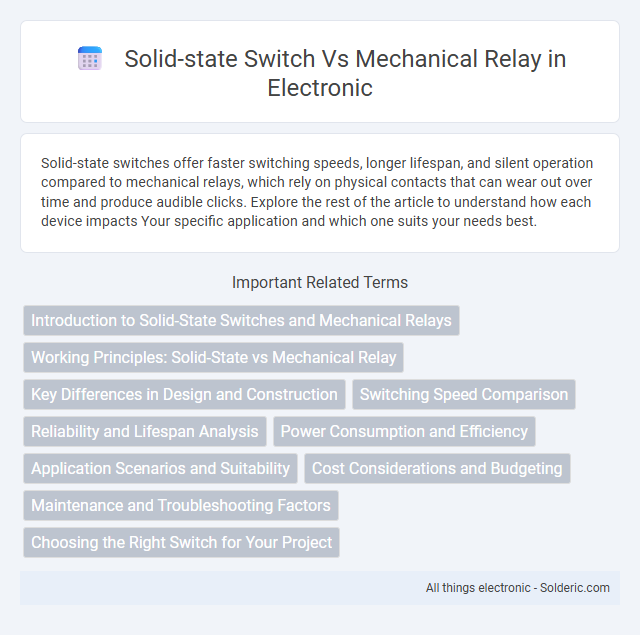Solid-state switches offer faster switching speeds, longer lifespan, and silent operation compared to mechanical relays, which rely on physical contacts that can wear out over time and produce audible clicks. Explore the rest of the article to understand how each device impacts Your specific application and which one suits your needs best.
Comparison Table
| Feature | Solid-State Switch | Mechanical Relay |
|---|---|---|
| Switching Speed | Microseconds to milliseconds | Milliseconds |
| Durability | High (no moving parts) | Lower (mechanical wear) |
| Noise | Silent | Audible clicking |
| Current Capacity | Typically lower, depends on type | Higher current ratings available |
| Control Voltage | Low voltage (logic level compatible) | Usually higher coil voltage required |
| Contact Isolation | Optical or semiconductor isolation | Physical galvanic isolation |
| Power Consumption | Low (continuous) | Higher (coil energized) |
| Cost | Higher initial cost | Lower initial cost |
| Application Examples | Fast switching, silent operation, sensitive electronics | High current loads, power switching, safety isolation |
Introduction to Solid-State Switches and Mechanical Relays
Solid-state switches utilize semiconductor devices such as thyristors, triacs, or transistors to control electrical power without moving parts, offering faster switching speeds and longer operational lifespan. Mechanical relays operate using an electromagnetic coil to physically move contacts, providing galvanic isolation and robust switching capabilities for high-power applications. Comparing these technologies reveals trade-offs between solid-state switches' silent operation and durability versus mechanical relays' simplicity and ability to handle higher surge currents.
Working Principles: Solid-State vs Mechanical Relay
Solid-state switches operate using semiconductor devices like thyristors or transistors to control current flow without moving parts, resulting in faster switching speeds and increased durability. Mechanical relays function through an electromagnetic coil that physically moves contacts to open or close circuits, which can introduce wear and slower response times. Understanding these working principles helps you choose the ideal switching solution based on speed, longevity, and noise requirements.
Key Differences in Design and Construction
Solid-state switches utilize semiconductor components, such as transistors or thyristors, enabling fast, silent switching with no moving parts, while mechanical relays rely on physical electromagnetic coils and metal contacts to open or close circuits. The absence of mechanical wear in solid-state switches enhances durability and longevity compared to mechanical relays, which are prone to contact degradation and mechanical fatigue. Thermal management is critical in solid-state devices due to heat generated by semiconductor operation, whereas mechanical relays are more influenced by mechanical stress and contact bouncing.
Switching Speed Comparison
Solid-state switches offer significantly faster switching speeds than mechanical relays, often measured in microseconds compared to milliseconds for mechanical devices. This rapid response time in solid-state switches improves performance in applications requiring high-frequency switching or precise timing control. Your choice of a solid-state switch ensures minimal delay and enhanced reliability in high-speed electronic circuits.
Reliability and Lifespan Analysis
Solid-state switches offer significantly higher reliability and longer lifespan compared to mechanical relays due to the absence of moving parts, which eliminates wear and contact erosion. Mechanical relays typically experience contact degradation and coil fatigue after 10 million operations, whereas solid-state switches can exceed 100 million cycles with minimal performance loss. This reliability advantage makes solid-state switches ideal for high-frequency switching applications and environments requiring reduced maintenance.
Power Consumption and Efficiency
Solid-state switches consume significantly less power compared to mechanical relays due to their semiconductor-based operation, which eliminates the need for coil excitation. Their efficiency is higher as there is minimal energy loss during switching, and they generate less heat, contributing to improved overall system performance. In contrast, mechanical relays incur continuous power draw to maintain coil activation and suffer from mechanical wear, leading to decreased long-term efficiency.
Application Scenarios and Suitability
Solid-state switches excel in high-speed switching, silent operation, and longevity, making them ideal for applications such as industrial automation, telecommunications, and low-voltage electronic circuits where rapid response and durability are critical. Mechanical relays are better suited for high-voltage, high-current environments like motor controls, automotive systems, and heavy machinery due to their robust physical contacts and ability to handle voltage spikes and surges. In scenarios requiring isolation and electrical noise immunity, mechanical relays provide superior performance, while solid-state switches offer improved energy efficiency and maintenance-free operation in compact electronic devices.
Cost Considerations and Budgeting
Solid-state switches typically incur higher initial costs compared to mechanical relays due to advanced semiconductor materials and manufacturing processes. However, their longer lifespan and lower maintenance requirements often result in reduced total cost of ownership over time. Mechanical relays offer a more economical upfront investment but may lead to increased expenses from wear and replacement in high-cycle applications.
Maintenance and Troubleshooting Factors
Solid-state switches require minimal maintenance due to the absence of moving parts, reducing wear and tear and extending device lifespan. Mechanical relays often demand regular inspection and replacement of contacts because of contact erosion and mechanical failures. Troubleshooting solid-state switches involves checking for electrical faults and overheating, while mechanical relay issues primarily focus on contact pitting and coil malfunctions.
Choosing the Right Switch for Your Project
Selecting the right switch for your project depends on factors like switching speed, durability, and electrical load. Solid-state switches offer faster switching speeds, longer lifespan, and silent operation, making them ideal for high-frequency or noise-sensitive applications. Mechanical relays excel in handling high voltage and current with clear on/off states, suited for applications requiring physical isolation and robust switching under heavy loads.
solid-state switch vs mechanical relay Infographic

 solderic.com
solderic.com